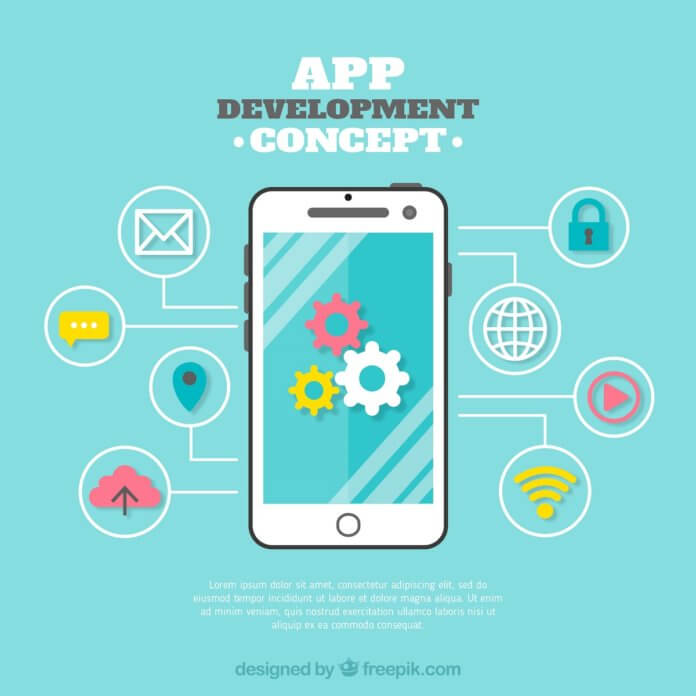If you’re thinking about developing a mobile app for your small or medium-sized business you have come to the right place! But before I walk you through the process of app development it is important to note that the app store is flooded with over 3 million apps, so before you make the decision to build the app, reflect and see if there is a need for your app to your audience. If it will really benefit their life for the better. Creating an app only because it is supposedly a ‘must have’ for brands is not a great idea. With that thought, let’s get started!
Step 1: Market Research and other initials
You might already have a few fantastic mobile app ideas for your company, which is a great place to start. However, before you start with the design and development phase, you should conduct extensive research on 3 major elements: your company, your target audience, and your competitors. Your app development team will need to have individuals from appropriate departments like executive leadership, marketing or sales, product development, IT, etc because in the initial stage you will need a lot of inputs from each of those team members and brainstorm the initial structure of your app. In this step of the process, you will also need to hash out the material you obtained during the research and discovery phases.
This stage is all about bouncing off ideas and being extremely creative, so don’t be afraid to have lots of fun with it. Maybe you and your team can have a brainstorm lunch session somewhere outside of your office space to get your creative juices flowing.
Step 2: Setting up goals and objectives
Setting the motto of your application is a crucial step in the development of your mobile App. After you’ve concluded that an app will help you achieve key goals in your mobile marketing strategy, you’ll need to figure out how your App will get you there.
- What problems would your app solve for your users?
- What characteristics will it have?
- What is the main USP of your App?
Determining the features and benefits of your App is frequently a balancing act between your entire app development budget and your in-house capabilities. However, research reveals that app design should prioritize consumer interaction over exclusive offerings when it comes to selecting functionality.
Step 3: Wireframes and Storyboard
It would be best to have a clear notion of how your App will appear and what functionality you want to incorporate at this point. It would help if you also created a scope of work that specifies which parts of the process will be handled in-house and outsourced.
Wireframing your App can be done using a variety of online tools. Your goal at this time is to create a clear image of how your ideas and suggested features will come together to form a viable app. A storyboard has a lot to do with user experience, it is a roadmap of what all the user will experience as soon as he/she downloads the app, it also derives the links between each screen and how users will move through the App.
Also Read: Top 15 Web Design Tools in 2021- For UI/UX, Prototyping & Wireframing
Step 4: Defining the backend of the App
Backend structures like APIs, data diagrams, servers, data integration, and push notification services are important elements of the app. Many SMEs believe that using a mobile backend as a service (BaaS) platform makes sense because it addresses typical issues, including scalability and a lack of in-house talent.
Moreover, if you face technical limits in the backend development process, you may need to adjust your wireframes or storyboard.
Step 5: Finalizing wireframes and testing prototypes
Any changes to your wireframe discovered during the backend planning process should be documented at this time. It’s time to develop an interactive prototype when your team has agreed on the wireframe and storyboard.
Another important part of developing an application is a prototype. It enables you to thoroughly evaluate design concepts, gather feedback, and find dead links and faults in the usability of your mobile app. There are various amazing prototype tools accessible online to make the process easier. You can also adapt the UI/UX to address any flaws discovered during this stage.
Step 6: Developing the App
Well, it is not easy as it sounds, a variety of phases and processes are involved in the actual development of the App. Your programmer will have to set up the exact storage solutions, databases, APIs, and servers for your App’s backend if you aren’t using an app development platform or mobile BaaS provider.
You also have to create developer accounts for the app stores where you plan to publish your software. You should also check the app store guidelines to avoid getting your App rejected during the review process.
Moreover, your designer will build the app “skins,” or real screens, for your mobile App at this point. These high-resolution renderings of your wireframes will be the interface your users will use to interact with your App in the future, so make sure your designs consider all of the ideas and input you gathered during the previous testing process.
Step 7: Testing and identifying the flaws
This is an exciting stage in the app development process since you now have a fully developed app concept with engaging graphics and well-placed text. You must now thoroughly test your App in various real-world circumstances to detect and repair any technological flaws. Look over each element again in your original design and planning documents; don’t assume something will work in the final concept just because it did during development.
Having a focus group meeting where people outside your company can come in and test your app is a good idea—they may have questions and insights that you aren’t aware of because you’ve been involved in app development since the beginning.
You may also utilize one of the online mobile UX testing tools that provide real-time feedback and statistics; several operate on a freemium basis that is cost-effective for small businesses. Make sure your photos, visuals, and user experience are cross-platform compatible. Once you’re confident, it’s working correctly in all scenarios. You can make the final preparations to launch your mobile app.
Step 8: Launch Prep
The measures you take to prepare for your app launch may have the largest impact on its eventual success, and one of the most crucial is involving your marketing department early in the process. Marketing can assist you with keyword research, which is necessary for SEO and app store optimization (ASO), which are important for discoverability.
As you prepare to launch your application to various marketplaces for distribution, your market and keyword research will drive your selections for app titles and descriptions. At this time, you’ll also want to gather high-resolution screenshots of your software, as well as a promotional video or demo.
To support and advertise your App, you’ll also need a website—or at the very least, a landing page. This is critical for both branding and awareness, as well as search and discoverability. Google’s App Indexing API uses content from your App and your App’s web page in its search results algorithm.
The name and icon of your App, badges, and names of the stores where it can be downloaded, screenshots and your promotional video, contact and support information, links to your social media accounts, a press kit, and, finally, testimonials and user reviews should all be included on the landing page for your App.
Make sure to market your App on your company’s social media profiles, and if you have a company blog, post updates during the development process to build excitement. Launching an email campaign is also an excellent option. You may also engage in the services of specialists and social influencers to help advertise your App, based on your market niche and the type of App you’re producing.
Remember to include app analytics in your app promotion checklist, which will help you optimize your app and will enhance its reach to your target audience. You can start with Google Analytics.
Keeping aside App Store and Google Play Store is an excellent time to think about other program marketplaces to distribute your App. You can also use PreApps, which is an app marketplace that connects developers with early adopters, as another option to investigate during the pre-launch phase for some pre-release feedback.
Launching the Application
That’s it: all the major steps of your app process are now behind you. Now all you have to do is nail the launch, it is not as easy as pressing a button and making your app live. There are some crucial things that you need to execute during your final launch. Your official release date should be the culmination of all of your app promotion efforts thus far. It’s time to generate some hype with press releases and articles from notable bloggers and journalists, as well as an announcement to everyone who showed interest in your App before its release. Use an email blast and mentions (with links) on all of your social media sites to promote your release.
The goal is to create downloads and ratings to gain traction. Once your App is published, don’t rest on your laurels; you’ll want to keep your new users engaged. This is an excellent opportunity to use push notifications to promote a special deal or promotion to encourage people to open your App.
Consider rewarding clients who download your App with a one-time discount or a free product or service. Keep in mind that promoting your software is a continuous activity, and your release-day activities are only the beginning.
Finally, establish a clear feedback channel and be sensitive to your users’ comments and concerns; a fast update or repair can go a long way toward maintaining your consumers. Pay attention to your statistics and track the key performance indicators (KPIs) that determine your marketing goals’ success.
You’ll be better equipped to design an app with the functionality and features you need—on a budget and timetable you can handle after you grasp the major procedures and milestones in the mobile app development lifecycle. Hopefully, this article helped you gain an insight on what developing an app for your business looks like. All the best!










Thank you for such an insightful blog. We would be glad to share with you more about related services, for more details https://www.prodigit.in/